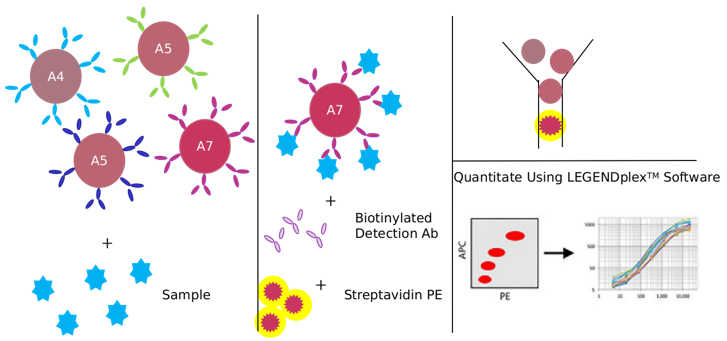Introduction to LRRK2 signaling pathway
Based on Luminex technology platform, Creative Proteomics provides analysis services for key targets of LRRK2 signaling pathway.
 Leucine-rich repeat kinase 2 (LRRK2) is encoded by the PARK8 gene of the Parkinson gene family and is abundant in brain striatal neurons. Recently, it was discovered that LRRK2 is involved in the molecular mechanism of Parkinson's disease. Knockout of the LRRK2 molecule will result in decreased activity of protein kinase A (PKA) of "striatal projection neurons" (SPNs), hyperphosphorylation of the regulator "Cofilin" of the cytoskeletal protein actin, and density of "dendritic spines" Reduced, synaptic fertility delay, showing the pathological characteristics of Parkinson's disease.
Leucine-rich repeat kinase 2 (LRRK2) is encoded by the PARK8 gene of the Parkinson gene family and is abundant in brain striatal neurons. Recently, it was discovered that LRRK2 is involved in the molecular mechanism of Parkinson's disease. Knockout of the LRRK2 molecule will result in decreased activity of protein kinase A (PKA) of "striatal projection neurons" (SPNs), hyperphosphorylation of the regulator "Cofilin" of the cytoskeletal protein actin, and density of "dendritic spines" Reduced, synaptic fertility delay, showing the pathological characteristics of Parkinson's disease.
LRRK2 gene is a member of the leucine-rich repeat kinase family. The protein encoded by it has ankryin repeat region, leucine-rich repeat (LRR) domain, kinase domain, dfg-like motif, RAS domain, GTPase domain, mlk-like domain and WD40 domain. In familial PD, mutations in LRRK2 are the most common than other genes. In addition, in terms of age of onset, disease progression, and motor symptoms, lrrk2-related PD is usually indistinguishable from sporadic PD.
The functional changes associated with LRRK2 mutations include changes in vesicle trafficking and cytoskeleton dynamics, autophagy and lysosomal degradation, neurotransmission, mitochondrial function, immunity and microglia response. It should be noted that the putative molecular mechanisms and degenerative characteristics associated with Parkinson's disease associated with LRRK2 are no different from most single-gene and sporadic Parkinson's disease.
LRRK2 is closely related to ERK1/2 and Wnt signaling pathways. Both LRRK2 and these two pathways affect the function in the nucleus. Outside the nucleus, the increased protein translation of LRRK2 by inhibiting the protein 4E-BP1 and the increase of mitochondrial autophagy all lead to the state of autophagy/lysosomal stress. LRRK2 promotes the increase of intracellular calcium and activates ERK1/2-dependent autophagy and down-regulation of dendritic mitochondria. LRRK2 and ERK1/2 also regulate the dynamics of microtubules in cells through phosphorylation of tau, actin, and tubulin. LRRK2 also triggers Wnt-β-catenin and ERK1/2-dependent gene transcription changes. The autophagy, transcription, and cytoskeleton effects of mutant LRRK2 expression contribute to ERK1/2-dependent neuron process shortening, while altered endosome/vesicle dynamics affect synaptic function.
Our detectable targets:
| BAK | Bax | PIDD | MYD88 | Rac1 | TLR4 |
| Bcl-xl | RIP1 | TRAF-2 | FADD | APAF-1 | BID |
| FADD | IRF7 | Mda-5 | NFκB | RIG-1 | TRAF3 |
| GAS | IRF9 | MEKK1 | p38 | RIP1 | TRAF5 |
| Histone-H3 | IRF5 | MEK3 | p38MAPK | SH2 | TRAF6 |
| IKK-α | IRS1 | MEK6 | p50 | SLP76 | TRAM |
| IKK-β | IRS2 | MSK1 | p65 | Tak1 | TRIF |
| IPS-1 | ISGF3 | MSK2 | PI3K | TBK1 | Vav |
| IRAK1 | ISRE | mTOR | PKR | TLR3 | |
| p53 | BID | IAPs | tBID | SODD | Bad |
Technology platform:
We provide Luminex technology for LRRK2 signaling pathway analysis.
Luminex technology is a multifunctional liquid phase analysis platform developed on the basis of colored microspheres, laser technology, applied fluidics and high-speed digital signal processing technology. The core is to encode polypropylene microspheres or magnetic microspheres with fluorescent dyes. By adjusting the different ratios of the two fluorescent dyes, up to 100 microspheres with different fluorescence spectra can be obtained. Antigen-antibody, enzyme-substrate, ligand-receptor binding reactions and nucleic acid hybridization reactions are performed on microspheres with different fluorescence encoding. Qualitative and quantitative analysis by laser detection of microsphere coding and reporter fluorescence separately.
The LRRK2 signaling pathway has been widely used in Western Blot, immunocytochemistry, immunohistochemistry and immunoprecipitation.
In addition to Luminex Multiplex Assay, Enzyme-linked immunosorbent assay (ELISA), Flow cytometry (FACS analysis) technology can also be provided to meet other customer needs.
Advantages of LRRK2 signaling pathway detection:
- High-throughput and high-speed: Each microsphere is used as a separate test body, which can perform a large number of biological tests at the same time. It only needs 10~201 samples to test up to 100 indicators at a time, and the fastest can reach 10,000 tests /hour.
- Good repeatability: The Luminex detection platform directly reads the fluorescence value, which is more stable and sensitive: 100 microspheres of each type are detected, and the median value is taken as the result, which is equivalent to 100 repeated detections for each sample.
- Low cost: Simultaneous detection of multiple indicators of a sample can save time, samples, reduce detection costs, and improve analysis efficiency.

Application of our service:
- To study the regulation mechanism of LRRK2 signal pathway in disease
- To study the effect of each virus on LRRK2 signaling pathway
- To study the effects of drugs or therapies on LRRK2 signaling pathways
Creative Proteomics has developed a signal pathway target detection platform. We are not limited to providing LRRK2 signal path detection services, but can also provide other signal path detection services. If you want to detect other targets, please contact us and we will customize the service for you. Look forward to working with you.
References:
- Verma M, Steer EK, et al. ERKed by LRRK2: a cell biological perspective on hereditary and sporadic Parkinson's disease. Biochim Biophys Acta, 2019, 1842(8): 1273-1281
- Rideout HJ, Chartier-Harlin MC, et al. The Current State-of-the Art of LRRK2-Based Biomarker Assay Development in Parkinson's Disease. Front Neurosci, 2020, 18(14): 865.
- Tolosa E, Vila M, et al. LRRK2 in Parkinson disease: challenges of clinical trials. Nat Rev Neurol, 2020, 16(2): 97-107.



